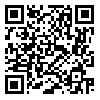Volume 10, Issue 2 (2-2021)
JCP 2021, 10(2): 261-270 |
Back to browse issues page
Download citation:
BibTeX | RIS | EndNote | Medlars | ProCite | Reference Manager | RefWorks
Send citation to:



BibTeX | RIS | EndNote | Medlars | ProCite | Reference Manager | RefWorks
Send citation to:
Tatar Y, Fadavi A, Koohsari H. Mitigation of Aspergillus flavus and its aflatoxins in wheat grains by gamma irradiation and calcium oxide. JCP 2021; 10 (2) :261-270
URL: http://jcp.modares.ac.ir/article-3-41567-en.html
URL: http://jcp.modares.ac.ir/article-3-41567-en.html
1- Department of Food Science and Technology, Azadshahr Branch, Islamic Azad University, Azadshahr, Iran.
2- Department of Food Science and Technology, Azadshahr Branch, Islamic Azad University, Azadshahr, Iran. ,fadavi.ac.ir@gmail.com
3- Department of Microbiology, Azadshahr Branch, Islamic Azad University, Azadshahr, Iran.
2- Department of Food Science and Technology, Azadshahr Branch, Islamic Azad University, Azadshahr, Iran. ,
3- Department of Microbiology, Azadshahr Branch, Islamic Azad University, Azadshahr, Iran.
Abstract: (2603 Views)
Aspergillus flavus is one of the important species of molds that can produce toxins during improper storage of wheat grains. In this study, different amounts of calcium oxide (0, 0.5, and 1%) were mixed with wheat samples containing mold spores. After 20 days, the samples were exposed to gamma radiation (0, 5, 10, 15, and 20 KGy). The presence of A. flavus, Aflatoxin B1 (AFB1), aflatoxin B2 (AFB2), aflatoxin G1 (AFG1), and aflatoxin G2 (AFG2) was assessed in samples. The results indicated that the effects of calcium oxide, gamma irradiation, and their interactions were significant on A. flavus, AFB1, and AFB2 contamination. Furthermore, other toxins like AFG1 and AFG2 were not found in the samples. An additional reduction in AFB1 and AFB2 was observed when irradiation was accompanied by Cao, and the maximum inhibition of aflatoxin production was achieved at 0.5% CaO. Consequently, based on the standard maximum limit of 10 KGy for cereals, the findings of this research suggest that 0.5% of calcium oxide and 10 KGy of irradiation could be applied in the storage of wheat grains to mitigate A. flavus, AFB1, and AFB2.
Article Type: Original Research |
Subject:
Mycology and Fungal Plant Diseases
Received: 2020/03/23 | Accepted: 2020/12/11 | Published: 2021/02/14
Received: 2020/03/23 | Accepted: 2020/12/11 | Published: 2021/02/14
Send email to the article author
| Rights and permissions | |
 |
This work is licensed under a Creative Commons Attribution-NonCommercial 4.0 International License. |









